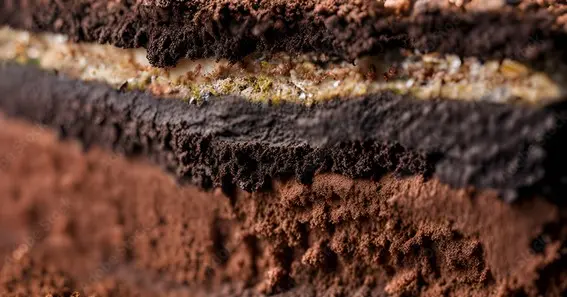What is topsoil? Topsoil is essential for plant development, farming, and environmental equilibrium. A straightforward query reveals the vast and intricate world underneath our feet. Life on Earth depends on the soil, which is alive and changing with creatures, chemicals, and organic matter.
Anyone interested in gardening, farming, or environmental protection must understand dirt, how it forms, why it’s vital, and how to maintain it. Plants and animals need dirt in little yards and vast farms. It is critical to the environment. Thsii article discusses more on what is topsoil.
What Is Topsoil?
Topsoil is the top 2–8 inches of soil. The majority of soil biological activity occurs here. This layer contains microorganisms, organic materials, and plant-growth compounds. It is black and rich because of humus and dissolved organic materials.
Topsoil quality varies with temperature, vegetation, and human activity, but supporting life is always crucial. Without this layer, the soil underneath would be unsuitable for plants, leaving plant-free zones. This short briefing should have given you a basic understanding on what is topsoil.
Formation And Composition Of Topsoil

Now you know a bit about what is topsoil, next let’s talk on its formation. Natural processes combine to form topsoil over hundreds to thousands of years. These include rock, organic debris, and soil-dwelling creatures. First, physical, chemical, and biological weathering breaks rocks into tiny bits.
Dead plants and animals decompose, improving soil. This procedure requires bacteria and fungi. Composting organic waste nourishes and conditions the soil. This carefully blended combination promotes plant growth and environmental equilibrium.
Topsoil contains sand, silt, clay, organic substances, water, air, and life. About half of excellent soil is water, air, and organic stuff. This equilibrium ensures optimum plant soil structure, drainage, and nutrient availability. These pieces work together to sustain various plant and animal life, which benefits the ecosystem.
Importance Of Topsoil In Agriculture
Next after learning about what is topsoil, you need to know about it’s importance. Dirt affects plant nutrition and conditions in agriculture. How much and what crops grow depends on soil fertility.
Farmers rotate crops, produce cover crops, and cultivate organically to improve the environment. These acts maintain soil structure, supply nutrients, and promote soil variety.
Farming is less effective with poor topsoil, resulting in lesser yields and food shortages. Healthy topsoil and sustainable farming practices are essential for food security and agriculture success.
Topsoil And Environmental Health

Plants support animal life and help maintain the Earth’s temperature, so topsoil is vital to the ecosystem. Topsoil provides water and nutrients, while plant root systems stabilize it to prevent erosion.
Healthy soil absorbs and stores carbon dioxide and delays climate change. Ants, worms, and microbes in the topsoil help keep it fertile and cycle nutrients. Due to this, topsoil health influences the entire environment, from plant and animal diversity to temperature.
Threats To Topsoil
Dirt, albeit vital, is threatened by natural and human activities. Wind, water, and human activity like tree cutting and overgrazing can wash away rich topsoil. Erosion is dangerous. Pollution, compaction, and soil organic matter loss are other serious issues.
Urbanization converts land from agricultural to other uses, removing dirt. Climate change increases extreme weather occurrences, affects weather patterns, and alters water availability, worsening these threats. These hazards demonstrate the need to conserve and repair topsoil to preserve food and environmental systems.
Conservation And Management Of Topsoil
Topsoil must be maintained and protected for crop and climatic health. Conservation tillage and contour farming preserve soil structure and prevent erosion. Organic matter from cover crops and composting improves soil structure and nutrition.
Buffer strips beside rivers prevent runoff and soil loss. People must understand the importance of dirt and how to cultivate sustainably to keep soil healthy. These conservation methods improve land health and ecological and agricultural resilience.
Role Of Topsoil In Gardening
Gardeners must understand soil to develop healthy plants. Gardeners may improve soil using fertilizer or dung. The soil becomes more stable and nutrient-rich. Mulching keeps dirt moist and prevents washing.
Regularly testing soil pH and nutrient levels ensures plants get enough sustenance. Rotating crops and not using harsh pesticides can help the soil stay healthy and attract diverse flora and animals. Farmers may create vibrant gardens that feed numerous plants and animals by focusing on soil health.
Conclusion
Finally, asking, What is topsoil? might teach you about an essential ecological phenomenon. Topsoil supports plants, crops, and environmental equilibrium. Its formation, composition, and importance to farming and the environment demonstrate the need for sustainable management to protect this unique resource.
Learning about threats and implementing protection measures can help us preserve the environment for future generations. Soil conservation is crucial for farming and the environment’s long-term health. This was an in depth article on what is topsoil.
FAQ
What Is Top Dirt?
Topsoil is the soil’s top layer. It contains nutrients and organic matter that plants need to thrive and maintain the environment. This layer usually extends 2–8 inches and contains many living creatures. It is crucial for environmental health and plant growth.
How Dirt Is Formed.
Over centuries to thousands of years, rocks and organic debris break down into topsoil. This process uses biological, chemical, and physical methods to transform rocks and organic debris into nutrient-rich soil. Topsoil production is gradual and complex, requiring several natural factors.
What Makes Valuable Soil For Farming?
Dirt affects plant nutrition and conditions in agriculture. Healthy topsoil increases soil structure, flow, and nutrient availability. This impacts food production and quality. Healthy topsoil keeps farming systems working and provides adequate food for everyone.
What Are Topsoil’s Primary Threats?
Most topsoil is at risk of washing away, polluting, and compacting, losing organic substance, causing cities to develop, and causing climate change. These items can reduce soil fertility and stability, harming agriculture and the environment. Eliminating these risks helps maintain the earth’s health and usefulness.
How To Manage And Protect Topsoil?
Conservation tillage, contour farming, organic matter, cover crops, and stream buffer strips preserve topsoil. To maintain soil health, people must be educated on proper farming practices. These conservation practices keep the soil fertile, prevent erosion, and enable sustainable farming.
Sources:
https://en.wikipedia.org/wiki/Topsoil
https://www.onlinesoil.co.uk/knowledge-base/general-info/what-is-topsoil








